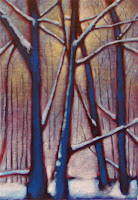Landscape and the Body
I'm very interested in the ways we inhabit our bodies and relate to our environment.
I see painting as a way of interpreting the information of the landscape through the human experience of the senses, memory, mythic imagination and physical energy. Very much a living process and highly individual. I'd like my paintings to communicate an experience.
I find I work at three types of painting. Meditations, Encounters and Discoveries. The
Meditation paintings are calm and still, based on colour and form. They are simple, less narrative.
Encounter paintings are more confrontational and animistic. The
Discovery paintings are often based on anthropomorphic qualities of trees.
So, this post begins at the beginning.
People don't grow on trees. Or step out of trees. That is the stuff of myth. Right? Have a look at this placenta. Well. Tree of Life?
I've played with these ideas before (see below), because the placenta is so full of potential. But it needs developing.
Paintings to come...

Landscape and the Body is a huge topic, and has been explored in many ways already. I'm going to look at a few different approaches I admire later in the week.
So, while I rewrite a novel that stalks me with its faults I remind myself that everything is a process. I've grown a branching tree of words, thrown in LOTS of fertiliser with the decent material and now I have to bonsai the wretched thing into something interesting and to the point, rather than an organic meditation on Stuff.
Sometimes you have to branch out and sometimes trim the branches. My problem is my 'thing' for interesting branches. I have a hard time hacking them off, even if I know they spoil the shape of the tree... Pathetic really. Excuse me while I sharpen my axe.





















